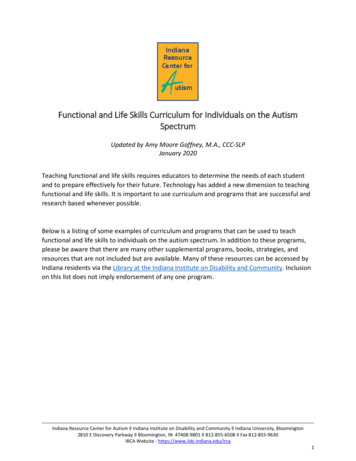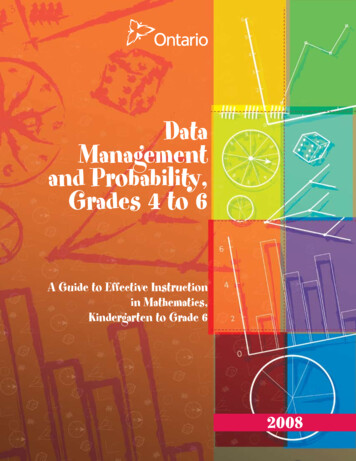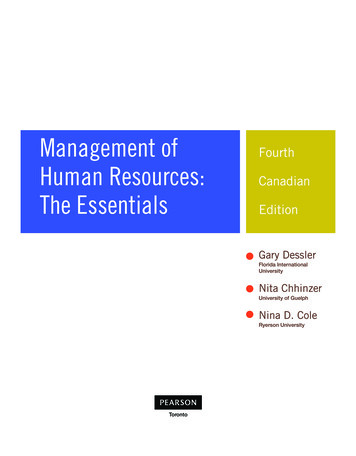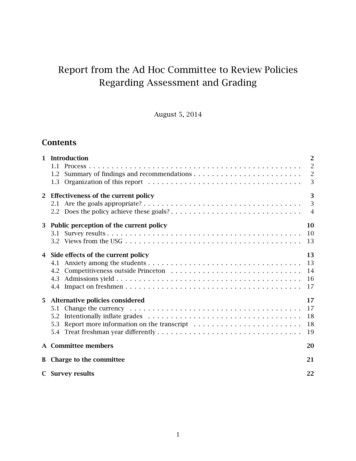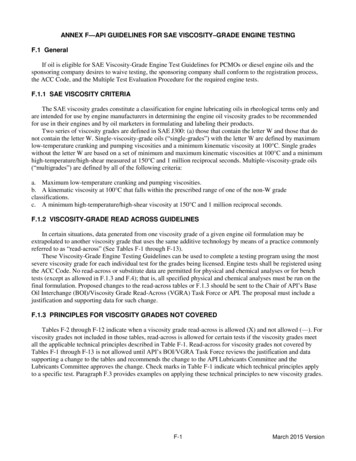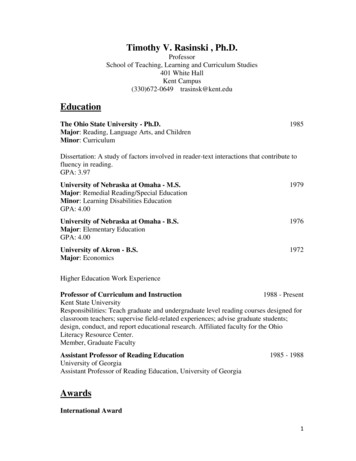
Transcription
Grades 6 to 8 Human Body SeriesNervous SystemKidsHealth.org/classroomTeacher’s GuideThis guide includes:The nervous system is like a network that relays messages back and forth from thebrain to different parts of the body. These messages allow you to do things likewalk, think, feel, be scared, and even breathe. The brain is the central computerthat controls all the functions of your body. These activities will help yourstudents understand how the nervous system works. Standards Related Links Discussion Questions Activities for StudentsRelated KidsHealth LinksArticles for Kids and Teens: Reproducible MaterialsBrain and Nervous .htmlMovie: The Nervous This guide correlates withthe following National HealthEducation Standards:Memory MattersStudents will: Comprehend concepts relatedto health promotion anddisease prevention to enhancehealth. Analyze the influence offamily, peers, culture, media,technology, and other factorson health behaviors. Demonstrate the ability toaccess valid information andproducts and services toenhance health. Demonstrate the ability to useinterpersonal communicationskills to enhance health andavoid or reduce health risks. Demonstrate the ability touse decision-making skills toenhance health. Demonstrate the ability to usegoal-setting skills to enhancehealth. Demonstrate the ability topractice health-enhancingbehaviors and avoid or reducehealth risks. Demonstrate the ability toadvocate for personal, family,and community lth.org/en/kids/memory.htmlWhat Are Reflexes?Why Do I Have Pain?KidsHealth.org/en/kids/pain.htmlDiscussion QuestionsNote: The following questions are written in language appropriate for sharing withyour students.1.What part of your body is considered the main control station?2.How are messages sent through your body to and from your brain?What parts of your body are included in your nervous system?3.What are nerve cells or neurons?How do they make connections within the brain and relay messages?4.How does your body feel pain?5.What is the fight or flight response?6.What would happen if a nerve connection broke?What kinds of things could break connections?Name some diseases, disorders, or injuries that could affect the nervous system.National Health ls/sher/standards/index.htm 2017 The Nemours Foundation/KidsHealth. Reproduction permitted for individual classroom use.
Grades 6 to 8 Human Body SeriesNervous SystemActivities for StudentsNote: The following activities are written in language appropriate for sharing with your students.Brainy ABCsObjectives:Students will: Explore the various parts and functions of the nervous system Generate a list of facts about the brain and nervous systemMaterials: KidsHealth articles and movie“Brainy ABCs” handoutClass Time: 1 hourActivity:Today you’re going to write an ABC guide to the brain and nervous system for kids in elementary school. Afterreading the KidsHealth articles and watching the movie about the brain and nervous system, use the “Brainy ABCs”handout as a guide to collect 26 facts, one for each letter of the alphabet. [Note to instructor: This can be doneindividually or with partners.] Facts should be a brief sentence or two that relate to the brain or nervous system. Tryto come up with facts that start with each letter of the alphabet. If you have trouble writing a fact that starts with acertain letter, just be creative! For example: A fact for X could be “Cerebral corteX is the term for the outer layer ofthe brain.”Extensions:1.Make a poster that shows kids and teens ways to be good to their brains. You can focus on things like eatinghealthy foods, exercising, wearing a helmet when riding bikes or playing certain sports, or staying away fromdrugs and alcohol.2.Using the posters and the completed “Brainy ABCs” handouts, have your students present a lesson on the brainand nervous system to an elementary school class.3.Go to KidsHealth.org/kid or TeensHealth.org and research a problem that can affect the nervous system. Writea brief report about the disease or disorder. 2017 The Nemours Foundation/KidsHealth. Reproduction permitted for individual classroom use.
Grades 6 to 8 Human Body SeriesNervous SystemBrain MapObjectives:Students will: Design a map of the brain Identify the five main parts of the brain and their functionsMaterials: Computer with Internet accessPaperCrayon, markers, colored pencilsClass Time: 1 hourActivity:After reading the KidsHealth.org articles related to the brain and nervous system, draw a map of the brain. Clearlylabel the parts of the brain and list their functions. Use the KidsHealth.org interactive diagram of the brain in the“Brain and Nervous System” article as a guide for your drawing.Extension:Create a map of the nervous system using an outline of a body. Clearly label the parts of the system and list theirfunctions.Reproducible MaterialsHandout: Brainy vous system handout1.pdfHandout: Brain ous system handout2.pdfQuiz: Nervous ervous system quiz.pdfAnswer Key: Nervous ervous system quiz answers.pdfKidsHealth.org is devoted to providing the latest children’s health information. The site, which is widelyrecommended by educators, libraries, and school associations, has received the “Teachers’ Choice Awardfor the Family” and the prestigious Pirelli Award for “Best Educational Media for Students.” KidsHealth comesfrom the nonprofit Nemours Foundation. Check out www.KidsHealth.org to see the latest additions! 2017 The Nemours Foundation/KidsHealth. Reproduction permitted for individual classroom use.
Personal Health SeriesNervous SystemName:Date:Brainy ABCsDirections: Write 26 facts related to the brain or nervous system in an ABC format for elementary school kids. Facts should startwith each letter of the alphabet, as much as possible. If you have trouble writing a fact that starts with a certain letter, just becreative! For example, a fact for A could be: “Amygdala is the part of the brain that’s responsible for emotions.” A fact for X couldbe: “Cerebral corteX is the term for the outer layer of the brain.”ABCDEFGHIJKLM 2017 The Nemours Foundation/KidsHealth. Reproduction permitted for individual classroom use.
Personal Health SeriesNervous SystemName:Date:Brainy ABCsDirections: Write 26 facts related to the brain or nervous system in an ABC format for elementary school kids. Facts should startwith each letter of the alphabet, as much as possible. If you have trouble writing a fact that starts with a certain letter, just becreative! For example, a fact for A could be: “Amygdala is the part of the brain that’s responsible for emotions.” A fact for X couldbe: “Cerebral corteX is the term for the outer layer of the brain.”NOPQRSTUVWXYZ 2017 The Nemours Foundation/KidsHealth. Reproduction permitted for individual classroom use.
Personal Health SeriesNervous SystemName:Date:Brain MapDirections: After reading the KidsHealth articles related to the brain and nervous system, draw a map of the brain. Clearlylabel the parts of the brain and list their functions. Use the KidsHealth.org interactive diagram of the brain (in the “Brain andNervous System” article) as a guide for your drawing. 2017 The Nemours Foundation/KidsHealth. Reproduction permitted for individual classroom use.
Personal Health SeriesNervous SystemName:Date:QuizInstructions: Answer each question.1.Youris the boss of your body and controls everything you do.2.The nervous system is made up of the brain, spinal cord, and3.The spinal cord helps carry4.How many nerves are in your body to send messages to brain and back?a. millionsb. billions5.What kinds of things are your brain and nervous system in charge of?a. walking and runningb. thinking and talkingc. feeling and sleepingd. breathing and growinge. all of the above6.How much does the average brain weigh?7.A neuron is another name for a8.Name one part of the brain and one of its functions:9.Both the brain and spinal cord are protected by.back and forth between your body and brain.cell.10. Name one function of cerebrospinal fluid: 2017 The Nemours Foundation/KidsHealth. Reproduction permitted for individual classroom use.
Personal Health SeriesNervous SystemQuiz Answer Keybrain1.Youris the boss of your body and controls everything you do.2.The nervous system is made up of the brain, spinal cord, and3.The spinal cord helps carry4.How many nerves are in your body to send messages to brain and back?a. millionsb. billions5.What kinds of things are your brain and nervous system in charge of?a. walking and runningb. thinking and talkingc. feeling and sleepingd. breathing and growinge. all of the above6.How much does the average brain weigh?About 3 pounds.7.A neuron is another name for a8.Name one part of the brain and one of its functions:(any one of the following: cerebrum, thinking or moving; cerebellum, balance or coordination; brain stem, breathing,circulation, or digestion; hypothalamus, body temperature, appetite, or sleep; pituitary gland, growth or metabolism)9.Both the brain and spinal cord are protected bymessages or signalsnervenerves.back and forth between your body and brain.cell.bone.10. Name one function of cerebrospinal fluid:(any one of the following: helps protect nerve tissue, keeps nerve tissue healthy, helps removes waste products from brainand spinal cord) 2017 The Nemours Foundation/KidsHealth. Reproduction permitted for individual classroom use.
Facts should be a brief sentence or two that relate to the brain or nervous system. Try to come up with facts that start with each letter of the alphabet. If you have trouble writing a fact that starts with a certain letter, just be creative! For example: A fact for X could be “Cerebral corteX is the

